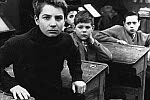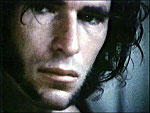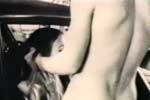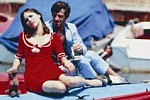 Shadows off the beaten path
Shadows off the beaten pathPARIS IS BURNING | PIERROT LE FOU
< < R E V I V A L S > >
last update 21.May.09
See also: SHADOWS FILM FESTIVAL
 R E V I E W B Y R I C H C L I N E
R E V I E W B Y R I C H C L I N E MUST
MUST  SEE
Les Quatre Cents Coups
SEE
Les Quatre Cents Coups
scr François Truffaut, Marcel Moussy
with Jean-Pierre Léaud, Claire Maurier, Albert Rémy, Patrick Auffay, Guy Decomble, Georges Flamant, Richard Kanayan, Daniel Couturier, François Nocher, Renaud Fontanarosa, Michel Girard, Jeanne Moreau

release Fr 3.Jun.59,
US 16.Nov.59,
UK 3.Mar.60
reissue UK 10.Apr.09
59/France 1h39
 Even though it was made 50 years ago, this film is strikingly timeless in its themes and approach to a story that, essentially, could be written today. And the acting is astonishingly natural.
Even though it was made 50 years ago, this film is strikingly timeless in its themes and approach to a story that, essentially, could be written today. And the acting is astonishingly natural.
Antoine (Leaud) is a feisty 12-year-old who lives with his bickering parents (Maurier and Remy) in a poor Paris neighbourhood. In class, the boys continually torment their teacher (Decomble), and Antoine often skips school, eventually running away from home, hanging out with his friend Rene (Auffay) and trying to make money by stealing a typewriter from his father's office. Caught in the act, Antoine's parents send him to reform school, where he starts to realise that he's alone in the world.
The film follows Antoine's odyssey in a remarkably intimate, free-form way as his childish cheekiness gives way to steely survivalism. The early schoolroom scenes bristle with youthful exuberance as these boys are up to something every time their teacher turns his back ("Poor France in 10 years time," he moans). And it's pretty depressing to watch this spirited resourcefulness and camaraderie being crushed both by the school system and by parents who are preoccupied with their own problems.
And as the story twists and turns, the characters dance around each other in ways that feel increasingly dangerous. And often very sad. Truffaut directs this with a casual insight, catching raw truth without forcing it on us. The film is fill of memorable sequences that are funny, sharp and deeply haunting, often all at the same time, using the breezy comedy to reveal much darker things beneath the surface. "Do you want to be expelled?" sighs the exasperated teacher. "I wouldn't say no," replies the boy.
And what's most astounding is the way this film stands up half a century later. By taking such an unsanitised approach, Truffaut cuts through the elements that lock this story in its place and time. These are just children who need love and a sense of belonging; these kids, and society at large, are paying the high cost of their parental indifference. And the beautiful final sequence gives the film an open resonance that echoes the first time you read Catcher in the Rye. Essential.
13.Feb.09
 R E V I E W B Y R I C H C L I N E
R E V I E W B Y R I C H C L I N E with The Sex Garage
with The Sex Garage
dir-scr Fred Halsted
with Fred Halsted, Joey Yale, Jim Frost, Rick Coates, Paul Barresi, Bob Blount
release US Apr.72,
UK Mar.09 llgff
72/US 55m

The Sex Garage
dir-scr Fred Halsted
with Gus Harvey, Sonia Boyd, Bob Madison
release US Apr.72,
UK Mar.09 llgff
72/US 35m


 Groundbreaking gay filmmaker Halsted has been compared to Kenneth Anger and Luchino Visconti for his innovative use of asynchronous sound and bold imagery linking sexuality, culture and technology. Indeed, these are the only two porn films in the permanent collection of New York's Museum of Modern Art.
Groundbreaking gay filmmaker Halsted has been compared to Kenneth Anger and Luchino Visconti for his innovative use of asynchronous sound and bold imagery linking sexuality, culture and technology. Indeed, these are the only two porn films in the permanent collection of New York's Museum of Modern Art.
LA Plays Itself starts in the idyllic mountains above Malibu, where Japanese music accompanies images of butterflies and beetles, then a man (Frost) walking through the woods where he encounters a naked man (Coates) swimming in a creek. In a seemingly overheard voiceover, they debate life in the city and country, and as they begin to have sex, the music shifts to Mozart.
Then bulldozers arrive to clear the land, and we cut to shots of gay hustlers hitchhiking on Hollywood Boulevard. The voiceover dialog is now between a seasoned sex worker (Halsted) and a young kid (his real-life partner Yale) just off the bus from Texas. As the older man offers to "show him the ropes", we see the younger one entering into scenes that turn to bondage and heavy sadomasochism.
All of this is remarkably shot with a grainy honesty that cuts through the sights and sounds to offer a rather creepy look at how man has perverted nature both through urban development and sexual dissatisfaction. The collision of images, disjointed dialog and various musical styles has an even stronger impact than the explicit sex. And a final glimpse of a Los Angeles Times headline about the Manson murders is deeply jarring.
The Sex Garage is a continuation of the same idea, shot as a co-feature in a mere six hours (as opposed to the four years it took Halsted to complete LA Plays Itself). It centres on a blond car mechanic who is having sex, both in a car and on the garage floor, with a rather enthusiastic hippie chick. Cut back and forth to a dark, hairy rich kid taking a lathery shower then driving his Mercedes to the garage. When he arrives, the girl runs off and he takes her place. They are then joined by a long-haired biker who gets bored with the threesome and goes off to have sex with his motorbike instead.
Beautifully shot with caressing camerawork and intriguing musical shifts (each character has his or her own musical genre), the film includes some Lynchian surrealism, as well as a bit of disturbing domination along the way. Both films show a remarkably astute cinematic eye, as the camera becomes an extension of Halsted's own lust. This is seriously uncanny filmmaking by someone who claimed to have no formal training or influences. Even nearly 40 years later he has the ability to both shock and to make us look at our surroundings in a different way.
27.Mar.09 llgff
 R E V I E W B Y R I C H C L I N E
R E V I E W B Y R I C H C L I N E
with Pepper LaBeija, Angie Xtravaganza, Willi Ninja, Dorian Corey, Kim Pendavis, Venus Xtravaganza, Freddie Pendavis, Octavia Saint Laurent, Carmen Xtravaganza, Brooke Xtravaganza, Paris Duprée, Eileen Ford
 release US 13.Mar.91,
release US 13.Mar.91, UK 27.Apr.09 dvd
90/US 1h13
 This beautifully assembled 1990 documentary looks at a specific segment of New York society. And by getting well beneath the surface, it also manages to engage us in surprising ways.
This beautifully assembled 1990 documentary looks at a specific segment of New York society. And by getting well beneath the surface, it also manages to engage us in surprising ways.
In 1987 Harlem, a group of young people had three strikes against them: they were black, male and gay. Instead of getting into trouble, they started a circuit of balls at which they paraded in competitions to win such categories as sexiness, dressing as schoolboys, town and country, executive wear, catwalk fashion, military uniforms and realness (how convincing could they be as a straight man or woman). Of course, battles in the ballroom were as fierce as on the streets, as they formed "houses" that took each other on like gangs.
As these balls become an integral to the life of these vibrant, creative men, they develop a sense of identity, purpose and belonging that had always eluded them. It's also the only chance of fame and immortality for kids who would never participate in sport. Filmmaker Livingston talks frankly with the participants, who share their stories and let their larger-than-life personalities flood across the screen. As a result, the film is fabulously camp and often very cheesy; for these men, life is about being sexy.
But there's also a strong economic element to this story as poverty-stricken participants work so hard to look rich and glamorous. Often, this means "mopping" or shoplifting an outfit or even their next meal. They also talk about "reading" each other with snappy put-downs and "shading" by conniving sneaky ways to win competitions. These are resourceful people who know they're not like everyone else. Most have been rejected by their families, but long to have a "normal, happy life", whatever that means.
And it's these yearning dreams that make the film take root. The film is assembled in a straightforward style, and Livingston cleverly draws out telling details. It's intriguing to see them adopt an almost hippie lifestyle, creating their own communities with their own rules in a society in which wealthy (mainly white) people earn most of the money and live the life the lives they want. Livingston puts this together with sensitivity and a colourful sense of humour. And the music is great too.
21.Apr.09
 R E V I E W B Y R I C H C L I N E
R E V I E W B Y R I C H C L I N E
with Jean Paul Belmondo, Anna Karina, Graziella Galvani, Georges Staquet, Dirk Sanders, Jimmy Karoubi, Krista Nell, Laszlo Szabo, Henri Attal, Raymond Devos, Aicha Abadir, Samuel Fuller
 release Fr 5.Nov.65,
release Fr 5.Nov.65, US 8.Jan.69
restored UK 22.May.09
65/France 1h50
 Ravishing photography, a terrific soundtrack and complete and utter unpredictability make this one of the most offbeat and hilarious films of the Nouvelle Vague. And yes, it's also pretentious, indulgent and ridiculous.
Ravishing photography, a terrific soundtrack and complete and utter unpredictability make this one of the most offbeat and hilarious films of the Nouvelle Vague. And yes, it's also pretentious, indulgent and ridiculous.
Bored with his bourgeois life, Ferdinand (Belmondo) abandons his wife (Galvani) and runs off with babysitter Marianne (Karina), who constantly calls him Pierrot ("But my name's Ferdinand," he replies each and every time). She's just double-crossed a gangster, so the two go on a cross-country crime spree, trying not to fall in love as they head to the Riviera, where they're confronted by a little man (Karoubi) before they can get in touch with Marianne's groovy gun-running brother (Sanders).
This is the kind of film that makes very little sense if you try to understand it. Even so, it's not Godard's least accessible film; there's a certain raucous charm that keeps us laughing all the way through, mainly because we never know what nuttiness we'll see next. There are a couple of gaudy musical numbers, some wildly absurd action and a few moments of bitterly ironic sentimentality (such as the sailor with the love song stuck in his head). The piece de resistance is the scene where Ferdinand and Marianne re-enact the Vietnam War to earn some cash from a group of chortling American tourists.
This is pure before-its-time post-modernism, as Godard tells a story that exists as much in the minds of his characters as in the world around them. We're never sure whether what we're seeing should be taken literally, and perhaps that's the whole point. The lurid colours and sets, huge shadows, Godard's slightly deranged way of framing scenes and a bevy of topless babes all place this film squarely in the 1960s, and yet it has an attitude that transcends its time and place.
And even today, it's achingly cool. Belmondo is at his charming best here, diving gleefully into Ferdinand's bizarro parable-odyssey and finding terrific chemistry with the hyperactively adorable Karina. On the other hand, it's impossible to care about these characters, as they're so completely self-absorbed and willing to betray each other in a flash. But whatever's happening, Godard's message is painfully resonant: love drives you mad.
30.Apr.09


See also: SHADOWS FILM FESTIVAL
© 2009 by Rich Cline, Shadows
on the Wall